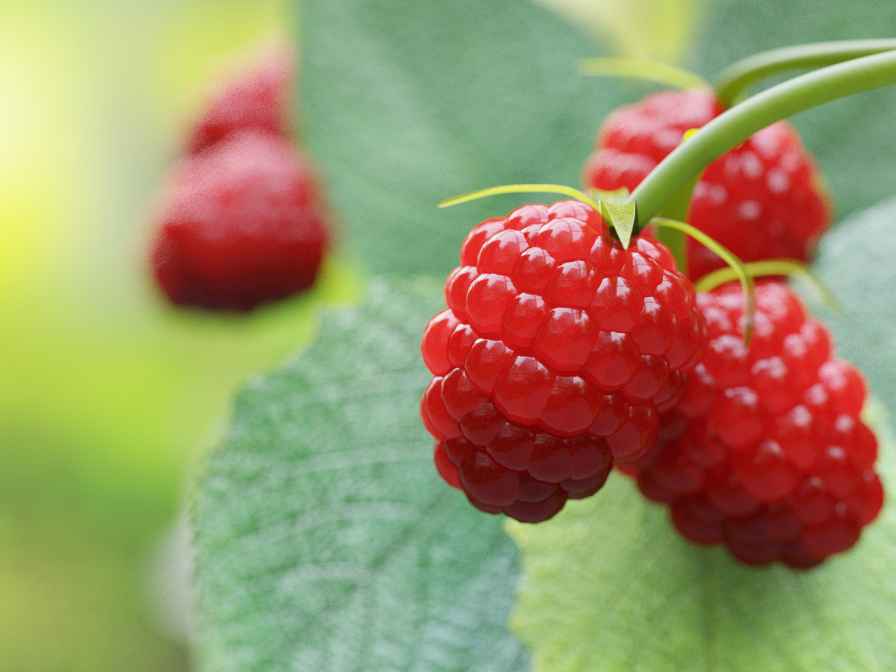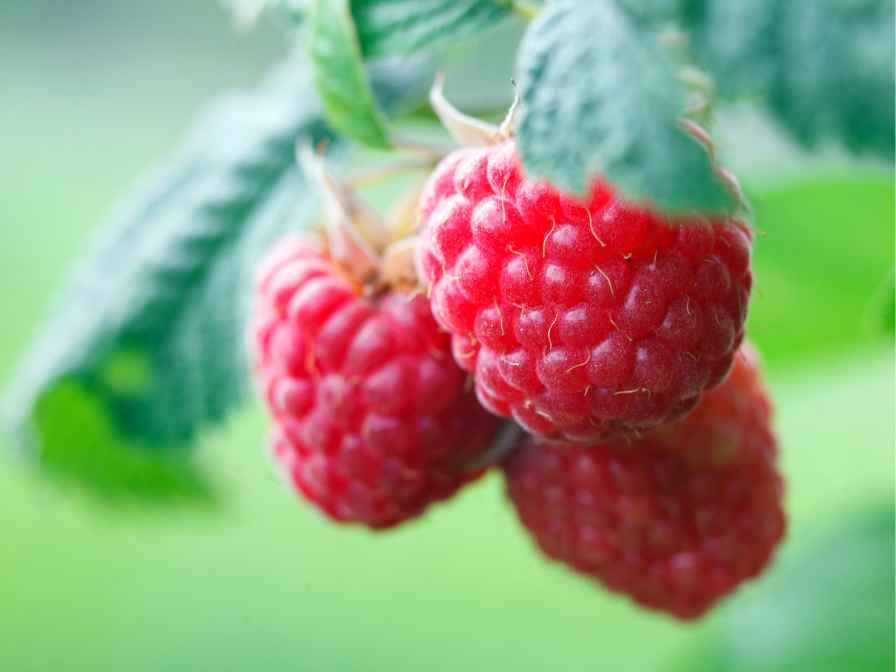When you have limited space and you want to grow fruit plants that are beneficial, easy to care and are also good looking, raspberries are a great choice. We are going to discuss growing raspberries in pots so that you can get the fruit of your choice in a limited space of the pot.

Raspberries
Raspberries are a type of fruit that grows on small, perennial bushes known as Rubus idaeus. They are native to Europe but are now widely cultivated throughout the world, including North America. It can be grown in the USDA zones from 4 to 8 in the united states.
Raspberries are typically small, red, and sweet, with a slightly tart flavor. They are rich in vitamins, minerals, and antioxidants, and are often eaten raw or used in a variety of culinary applications, including jams, jellies, and baked goods.
Raspberries are also a good source of dietary fiber, which can help regulate digestion and promote feelings of fullness. Raspberries contain fewer calories. These are great for people who want to manage their weight or maintain a healthy diet
In addition to their nutritional benefits, raspberries have been associated with a lot of potential health benefits, which include controlled inflammation, good heart health, and improved cognitive function. Still, there is a need for more research to fully understand and validate all of the benefits.
Benefits of Growing Raspberries in Pots
There are many benefits of growing raspberries in pots, as it is very easy to get the fruit in the limited space settings:
Convenience
Growing raspberries in pots allows you to grow them in small spaces, such as balconies or patios. This makes them a great option for urban gardeners or those with limited outdoor space. It also adds ornamental value to the space in which it is being planted.
Control
Growing raspberries in pots allows you to control the growing conditions, such as soil quality, water levels, and sunlight exposure. This can result in healthier plants and a better yield. As it is a concentrated space, you can control all the factors of inputs.
Mobility
Potted raspberries can be moved around as needed, which can be particularly useful if you need to protect them from extreme weather conditions or pests. You can also move the pots for sun exposure and to place them in the optimal spot.
Protection
Growing raspberries in pots can also help protect them from pests and diseases that can be prevalent in garden soil. This can reduce the need for pesticides and other chemical treatments. You will be able to get more organic yield.
Extended Growing Season
In colder climates, potted raspberries can be brought indoors during the winter months, which can extend the growing season and provide fresh berries year-round. Also, good care in indoor settings adds to the life span of the plants.
Overall, growing raspberries in pots can be a great option for those looking to enjoy the benefits of fresh, homegrown raspberries conveniently and flexibly. Even if you are a beginner gardener, you can try it.
Growing Raspberries in Pots
Growing raspberries in pots require a few basic steps to follow. Here are the steps to grow the raspberries in the pots:
Choose the Right Pot
Raspberries need plenty of room to grow, so choose a pot that is at least 18 inches in diameter and 20 inches deep. Make sure the pot has drainage holes at the bottom to prevent water from pooling and damaging the roots.
Choose the Right Soil
Raspberries prefer well-draining soil that is rich in organic matter. You can use the potting mix which has vermiculite, peat moss, and perlite. Avoid using garden soil as it can be heavy and compact, which can suffocate the roots.
Plant the Raspberry Bush
Fill the pot with soil within a few inches of the top. Dig a hole in the center of the soil that is slightly larger than the root ball of the raspberry plant. Gently remove the plant from its container and place it in the hole. Backfill with soil, making sure the plant is at the same depth as it was in its original container. Water thoroughly.
Provide Support
Raspberries need support as they grow to keep the canes upright and prevent them from breaking. Place a trellis or stake in the pot at planting time to provide support for the plant. Make sure that the support doesn’t harm the plant.
Taking Care of Raspberries in Pots

Here are the items to consider while taking care of the raspberries in the pots:
Water Regularly
Raspberries in pots need regular watering, especially during hot weather. Keep the soil evenly moist but not waterlogged to prevent root rot. Water deeply at the base of the plant rather than spraying the leaves, which can encourage disease.
Fertilize Regularly
Raspberries in pots need regular fertilizing to ensure they have enough nutrients to grow and produce fruit. Use a balanced, water-soluble fertilizer every two weeks during the growing season. Follow the package instructions for the correct amount to use.
Prune Regularly
Pruning raspberries regularly will help keep the plant healthy and productive. Remove any dead or damaged canes, and prune the remaining canes back to about 2-3 feet tall in late winter or early spring. This will encourage new growth and fruiting.
Protect from Pests and Diseases
Potted raspberries can be more susceptible to pests and diseases than those grown in the ground. Keep an eye out for common pests like aphids, spider mites, and raspberry cane borers. If you notice any signs of disease or infestation, treat the plant promptly with an appropriate pesticide or fungicide.
Overwintering
In colder climates, you can overwinter potted raspberries indoors by placing them in a cool, dark location such as a basement or garage. Stop watering the plant in the fall, and wait until the soil is dry before moving the pot indoors. Prune the canes back to about 6 inches tall and store the pot in a location with temperatures between 0-5°C (32-41°F).
Harvesting and Storing Raspberries
Harvesting and storing raspberries properly can help ensure that you enjoy the full flavor and freshness of your homegrown fruit. Here are some tips for harvesting and storing raspberries:
Harvesting
Raspberries are ready to be harvested when they turn a deep red color and easily pull off the stem. Gently grasp the berry and give it a slight tug. If it comes off easily, it’s ready to be picked. Be careful not to squeeze or crush the berries as you pick them, as this can cause them to spoil more quickly.
Storing
Raspberries are best eaten fresh, but they can also be stored for a few days in the refrigerator. Lay the single layer of the berries in a shallow container lined with paper towels. Cover the container with plastic wrap or a lid, and store it in the refrigerator.
Do not wash the berries until you are ready to eat them, as this can cause them to spoil more quickly.
Freezing
If you have more raspberries than you can eat or store in the refrigerator, you can freeze them for later use. To freeze raspberries, wash them gently in cold water and pat them dry with paper towels.
Get the baking sheet and spread a layer of the berries on it. Place it in the freezer until it is frozen. Place them in the airtight bag, and get them to the freezer. You can freeze them for almost six months.
Preserving
Raspberries can also be preserved by making them into jams, jellies, or sauces. Follow a trusted recipe and can the preserves according to recommended guidelines to ensure they are safe to eat. You can preserve them if you want.
In short, raspberry is a true blessing of nature. It is because these plants can be grown even in pots and can be treated as full fledge fruit plantlike fruit trees. You will surely enjoy the growing process and yield from it.
FAQs
Do raspberries grow well in pots or the ground?
Raspberries do well in all soil types and forms like pots, garden beds, and in the ground. It is because they spread well it is suggested to use garden beds. You can choose a wide pot for good growth.
What soil do raspberries need in the pots?
Raspberries need soil that has good drainage. The PH of the soil can be between 6 to 6.5 like it is slightly acidic. Make sure the soil in which raspberries are being planted can hold the nutrients. It will make sure the plant gets the required nutrients.
How long do raspberry plants live?
Well, it depends on the type of raspberry plant you are going to plant in the pots. Red raspberries can last for 10 to 15 years. While black raspberries can last for 5 to 10 years. Other factors like nutrients, attacks of pests and diseases, water availability, etc. are also important in this regard.

